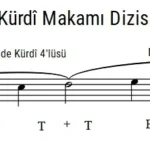The Bayati Makam (a mode in Turkish Classical Music), believed to have derived its name from the Bayat Turks, a branch of the Oghuz Turks, has been in use for approximately five centuries. However, its originator remains unknown.
Uşşak makam (a mode in Turkish Classical Music) , although using the same scale, differs by starting its melodic progression from the middle pitches rather than the lower ones. This feature exemplifies that in Turkish music, the concept of a makam is shaped more by its melodic development (seyir) than by the scale (dizi) itself.
Bayati makam, compared to Uşşak makam, has a less melancholic character and is classified among the simple makams.
Bayati Ney Taksimi – Aka Gündüz Kutbay
The final note is Dügâh (A).
It has an ascending (rising) character, which is the first feature that distinguishes it from the Uşşak makam.
It is the Neva (D) pitch at the junction of the tetrachord and pentachord. A half-cadence with the Buselik mode is performed on this pitch.
On the Segâh pitch, incomplete Ferahnâk and incomplete Segâh temporary cadences (asma karar) are performed; additionally, temporary cadences with Rast are made on the Rast pitch.

Additionally, the Acem pitch (F) is very important for the Bayati makam. The melodic progression often begins around this pitch. The interval between Neva (D) and Acem (F) is frequently used. (This is the second difference from the Uşşak makam.)
Also, during the Bayati progression, as it approaches the end (but not at the very end), a Hijaz modulation is made on Neva, followed by temporary cadences with Hijaz on Neva and Nikriz on Çârgâh. (This is the third difference from the Uşşak makam.)
As in the Uşşak makam, only a one-comma flat is applied to the B note in the tuning system.
Dügâh (La / A), Segâh (Si / B♭), Çârgâh (Do / C), Nevâ (Re / D), Hüseynî (Mi / E), Acem (Fa / F), Gerdâniye (Sol / G), Muhayyer (La / A♭)
The sounds of the Hijaz mode on Neva and the Nikriz mode on Çârgâh are Neva (D), Hisar (C♯), Eviç (F♯), and Gerdâniye (G).
It is the G (Sol) pitch on the second line (Râst).
While the Uşşak makam expands in the lower (bass) region, the Bayati makam expands in the higher (treble) region. It does not expand in the lower region at all; if it uses bass notes, it employs the sounds of the Rast pentachord on Yegâh, just like Uşşak. (See:Uşşak Makam (a mode in Turkish Classical Music))
In the high register, it also expands in two different ways.
- 1. The Uşşak tetrachord on the tonic pitch is transposed to the high tonic, resulting in symmetric expansion.

- 2. It expands by creating a new scale through adding a Kürdî tetrachord on the Muhayyer pitch to the Bûselik pentachord on the Neva pitch.

Note: In the progression of the Bayati makam, prolonged stays that would create a suspended cadence on the Muhayyer pitch are avoided.
The melodic progression begins around the strong Neva pitch. The Acem (F) pitch is frequently emphasized while navigating the scale. A half cadence with Bûselik is performed on the Neva pitch. Then, the scale is explored further with necessary suspended cadences. Near the ending, a Hijaz modulation is shown on Neva, and finally, a full cadence with Uşşak is made on Dügâh.
- The Uşşak makam has an ascending (rising) melodic character, while the Bayati makam features both ascending and descending melodic movement.
- The Bayati makam frequently utilizes the interval between the Neva and Acem pitches (especially more so in the opening progression). In contrast, the Uşşak makam rarely dwells on these pitches, focusing more on the tonic and its lower neighbor.
- In the Bayati makam, especially as it approaches the cadence, descending melodies feature a Hijaz modulation on the Neva pitch. This modulation is absent in the Uşşak makam (although there are exceptional pieces that include it).
- The Uşşak makam expands in the lower register (bass) around the tonic pitch, using the Rast pentachord on Yegâh borrowed from the Rast makam. In contrast, the Bayati makam expands in the upper register (treble) above the high tonic, through symmetric expansion and by creating a new scale.






